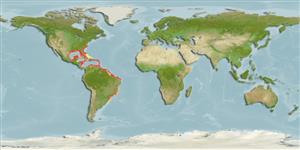Common names from other countries
>
Pleuronectiformes (Flatfishes) >
Cynoglossidae (Tonguefishes) > Symphurinae
Etymology: Symphurus: Greek, syn, symphysis = grown together + Greek, oura = tail (Ref. 45335); diomedeanus: Named for the Greek hero in the Trojan Was, Diomedes..
More on authors: Goode & Bean.
Environment: milieu / climate zone / depth range / distribution range
Ecología
marino asociado a arrecife; rango de profundidad 6 - 263 m (Ref. 5951), usually 21 - 80 m (Ref. 26268). Subtropical; 36°N - 40°S, 98°W - 35°W (Ref. 26268)
Western Atlantic: Canada (Ref. 5951) to north of Cape Hatteras, North Carolina through the Gulf of Mexico and the Caribbean Sea, inner continental shelf of South America to about Isla de Flores, Uruguay.
Tamaño / Peso / Age
Maturity: Lm ? range ? - ? cm
Max length : 22.0 cm TL macho / no sexado; (Ref. 35237); common length : 18.0 cm TL macho / no sexado; (Ref. 3716)
Espinas dorsales (total) : 0; Radios blandos dorsales (total) : 90 - 92; Espinas anales: 0; Radios blandos anales: 73 - 77.
Does not usually occur in shallow coastal or estuarine waters (Ref. 26268). Found on muddy bottoms. Feeds mainly on various benthic invertebrates particularly crabs and polychaete worms (Ref. 35237).
Life cycle and mating behavior
Maturities | Reproducción | Spawnings | Egg(s) | Fecundities | Larva
Robins, C.R. and G.C. Ray, 1986. A field guide to Atlantic coast fishes of North America. Houghton Mifflin Company, Boston, U.S.A. 354 p. (Ref. 7251)
IUCN Red List Status (Ref. 130435)
CITES (Ref. 128078)
Not Evaluated
Threat to humans
Harmless
Human uses
Pesquerías: de interés potencial
Herramientas
Special reports
Download XML
Fuentes de Internet
Estimates based on models
Preferred temperature (Ref.
115969): 19.7 - 27.5, mean 24.7 (based on 270 cells).
Phylogenetic diversity index (Ref.
82804): PD
50 = 0.5000 [Uniqueness, from 0.5 = low to 2.0 = high].
Bayesian length-weight: a=0.01445 (0.00647 - 0.03228), b=3.05 (2.85 - 3.25), in cm Total Length, based on LWR estimates for this (Sub)family-body shape (Ref.
93245).
Nivel trófico (Ref.
69278): 3.3 ±0.46 se; based on food items.
Resiliencia (Ref.
120179): Alto, población duplicada en un tiempo mínimo inferior a 15 meses (Preliminary K or Fecundity.).
Fishing Vulnerability (Ref.
59153): Low vulnerability (12 of 100).
